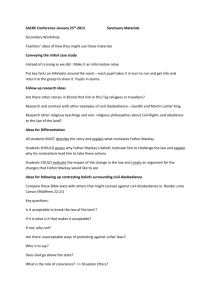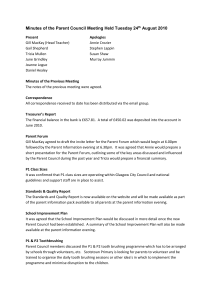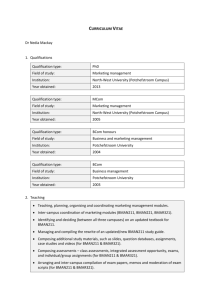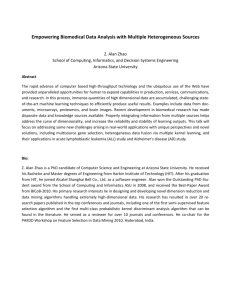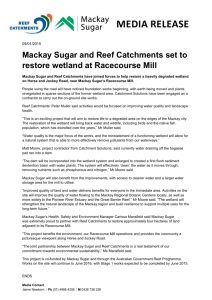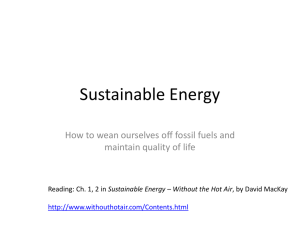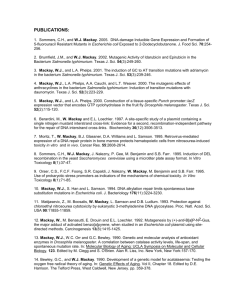Alan MacKay - Birkbeck College
advertisement
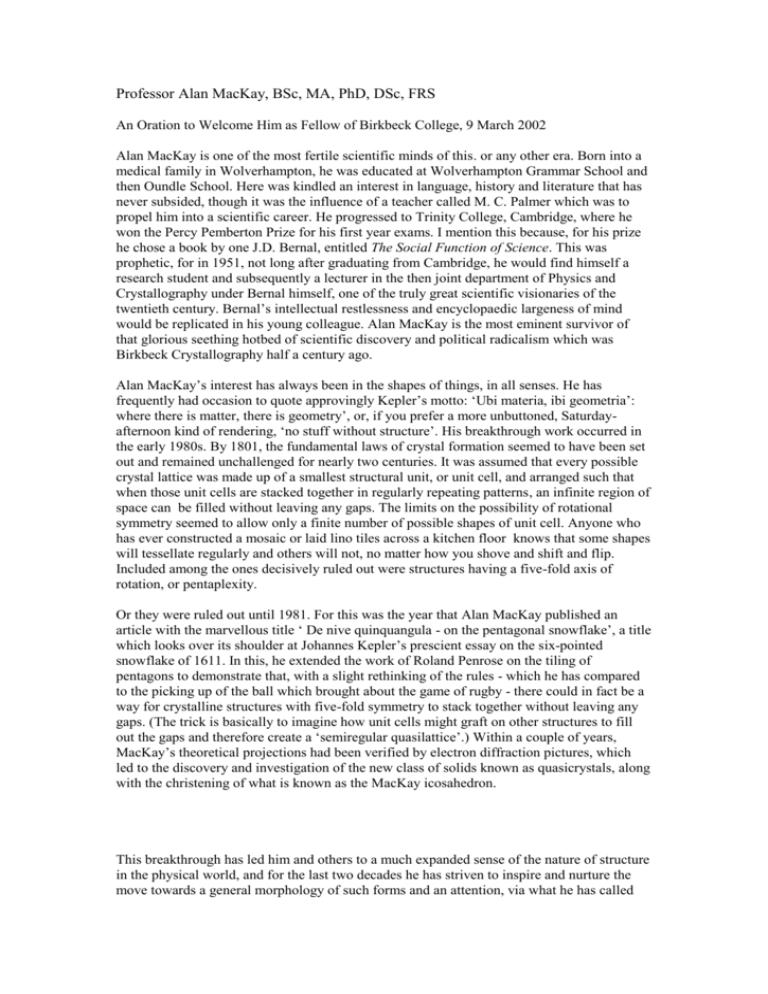
Professor Alan MacKay, BSc, MA, PhD, DSc, FRS An Oration to Welcome Him as Fellow of Birkbeck College, 9 March 2002 Alan MacKay is one of the most fertile scientific minds of this. or any other era. Born into a medical family in Wolverhampton, he was educated at Wolverhampton Grammar School and then Oundle School. Here was kindled an interest in language, history and literature that has never subsided, though it was the influence of a teacher called M. C. Palmer which was to propel him into a scientific career. He progressed to Trinity College, Cambridge, where he won the Percy Pemberton Prize for his first year exams. I mention this because, for his prize he chose a book by one J.D. Bernal, entitled The Social Function of Science. This was prophetic, for in 1951, not long after graduating from Cambridge, he would find himself a research student and subsequently a lecturer in the then joint department of Physics and Crystallography under Bernal himself, one of the truly great scientific visionaries of the twentieth century. Bernal’s intellectual restlessness and encyclopaedic largeness of mind would be replicated in his young colleague. Alan MacKay is the most eminent survivor of that glorious seething hotbed of scientific discovery and political radicalism which was Birkbeck Crystallography half a century ago. Alan MacKay’s interest has always been in the shapes of things, in all senses. He has frequently had occasion to quote approvingly Kepler’s motto: ‘Ubi materia, ibi geometria’: where there is matter, there is geometry’, or, if you prefer a more unbuttoned, Saturdayafternoon kind of rendering, ‘no stuff without structure’. His breakthrough work occurred in the early 1980s. By 1801, the fundamental laws of crystal formation seemed to have been set out and remained unchallenged for nearly two centuries. It was assumed that every possible crystal lattice was made up of a smallest structural unit, or unit cell, and arranged such that when those unit cells are stacked together in regularly repeating patterns, an infinite region of space can be filled without leaving any gaps. The limits on the possibility of rotational symmetry seemed to allow only a finite number of possible shapes of unit cell. Anyone who has ever constructed a mosaic or laid lino tiles across a kitchen floor knows that some shapes will tessellate regularly and others will not, no matter how you shove and shift and flip. Included among the ones decisively ruled out were structures having a five-fold axis of rotation, or pentaplexity. Or they were ruled out until 1981. For this was the year that Alan MacKay published an article with the marvellous title ‘ De nive quinquangula - on the pentagonal snowflake’, a title which looks over its shoulder at Johannes Kepler’s prescient essay on the six-pointed snowflake of 1611. In this, he extended the work of Roland Penrose on the tiling of pentagons to demonstrate that, with a slight rethinking of the rules - which he has compared to the picking up of the ball which brought about the game of rugby - there could in fact be a way for crystalline structures with five-fold symmetry to stack together without leaving any gaps. (The trick is basically to imagine how unit cells might graft on other structures to fill out the gaps and therefore create a ‘semiregular quasilattice’.) Within a couple of years, MacKay’s theoretical projections had been verified by electron diffraction pictures, which led to the discovery and investigation of the new class of solids known as quasicrystals, along with the christening of what is known as the MacKay icosahedron. This breakthrough has led him and others to a much expanded sense of the nature of structure in the physical world, and for the last two decades he has striven to inspire and nurture the move towards a general morphology of such forms and an attention, via what he has called 2 ‘flexi-crystallography’, to the varied and surprising structures which lie outside the beautiful, but somewhat austere domain of classical crystallography. I think it is no accident that crystallographers of Alan MacKay’s composition are so sensitive to the links between the small and the large, the local and the global. This is the science which explains how the arrangements of atoms in frozen water result in the distinctive whorls and swirls on your car windscreen on a frosty morning, or the exquisite lacey shapes of a snowflake. It was crystallography, ‘an apparently harmless subject concerned with the forms of crystals’, as Alan MacKay once archly described it, which also lay behind the most momentous discovery of our era, the double helix, in 1953. Crystallography thus provides an allegory for the larger ideals of connection and communication which have driven Alan MacKay all through his life. He has sought to make connections across the separated geographical spaces of different cultures. He has spent much time teaching and researching abroad, particularly in the countries of the East, China, Korea and Japan. This experience has helped him to augment his already considerable store of languages. One story I have been told concerns a graduate student who asked him for help with a paper in Chinese which he had been sent and of which he could make nothing. After a few minutes scanning it, Professor MacKay gave the student a summary translation, and handed the paper back, adding casually, ‘By the way, it’s not in Chinese, it’s in Korean.’ One of the testimonies to the enlargement and mingling of perspectives which are so important to him is the book of poems he published in 1980, many on scientific topics, entitled Floating World. Its title a metaphor for the ideal ‘floating world’ of international scientific enquiry, and the poems are all about meeting and mingling. These themes are also borne out in the illustrations to the volume, which set Japanese calligraphy alongside Roman mosaic, integrated circuits, a fully-rigged nineteenth-century sailing ship and a picture of what is helpfully captioned as ‘a rhombic triacontahedron filled with acute and obtuse rhombohedra according to a non-periodic packing rule’. I don’t have a slide of that, but I am sure you can conjure it up in your mind’s eye. Just to complete the motley and multifarious iconography of the book, when I was reading the British Library copy of the book, a compliments slip from Alan MacKay himself fell out of it, written on one side of a Fortran card, looking now as ancient and mysterious as an inscription in Sumerian. This little objet trouvé had been between the pages of a poem entitled ‘Written on an Egyptian Vomit Bag Over the Pacific Ocean’. I take from this poem these emblematic words which seem to offer a crystallographic perspective on cultural interconnection: Our world is of water, like the sea, But the molecules sparsely spread, Not independent, not touching, But somewhere in between1 As well as overcoming geographical divisions, Alan MacKay also sought connections between disciplines. He has always been profoundly interested in the social life and meaning of science. To that end he co-edited in 1964 a volume entitled The Science of Science: 1 Floating World: Poems (London: RAM Press, 1980), p. 28. 3 Society in the Technological Age. He was a founder member of the Science Policy Foundation, which had the aim of promoting ‘the scientific investigation of science and technology as social phenomena’. He has always had a sharp eye for the sometimes bizarre collisions of real world motivations and significant advances in science. During the 1980s he contributed a wry column on the human motivations of science to the journal The Sciences. In a recent article he tells the story of how V.M. Goldschmidt was set up as an X-ray crystallographer by a Norwegian government grateful for his part in showing that calcium carbide was inorganic and thus exempt from the import duty being charged by the Britain. In 1977, he published the first edition of his marvellous anthology of scientific quotations, a volume which is quite indispensable for orators, encomiasts and public sounders-off of all descriptions. He describes in the preface how his squirrel-like habit of accumulating quotations began in 1940, when one S.G. Squires, a classics master at Oundle, instructed every pupil to acquire a notebook in which to collect Latin quotations. ‘So each morning’, he has written, ‘while the British Empire crumbled, we learnt a new Latin tag’. The anthology, in which Albertus Magnus, Galileo, Lord Kelvin and Bronowski get their words in edgeways alongside Wyclif, Keats and Dylan Thomas, aims ‘to show the wholeness of our culture’. It is a direct expression of the ‘international and intercultural crossroads’ of the Bernal laboratory, in which social, scientific and political thinking combined and fertilised each other. And finally, Alan MacKay has sought to throw bridges between the present and the past. The Roman historian Livy prayed for the gift of forgetfulness in preference to that of memory, and most contemporary scientists would probably go along with this. In contrast to the arts and humanities, which operate predominantly under the muse of Mnemosyne, scientists need to be amnesiac in order to move on. In Alan MacKay’s own somewhat caustic words, ‘How can we have any new ideas or fresh outlooks when 90% of all the scientists who have ever lived have still not died?’ In fact, however, Alan MacKay has always adopted Napoleon’s principle of reculer pour mieux sauter, for, as well as being a formidable and forwardlooking scientist, he is one of the most erudite and sensitive historians of science. The breadth of his knowledge and the subtlety of his appreciation are nothing short of majestic. A couple of years ago, he published a translation of Ernst Haeckel’s Crystal Souls: Studies of Inorganic Life. A journeyman translator would have been content with a listing of Haeckel’s proximate influences and estimation of his contribution. Alan MacKay’s introduction begins, as Sam Goldwyn recommended a good film should, with an earthquake, and then works up to a climax. The earthquake in question is the breezy remark, inspired by the discovery of liquid crystals by F. Reinitzer in 1888, that ‘it is probably only a matter of time now before a recognisably living system will be assembled from non-living components.’ The breathtaking range of reference on display in that essay includes not only Haeckel’s immediate associates but also Bacon, Kepler, Goethe, Darwin, Freud, Jung, Marx. He reminds us that Marx and Engels feuded with Lord Kelvin and P.G. Tait on the question of the tides raised by the moon, and gives us the names of the only two fellows of the Royal Society to attend the funeral of Karl Marx. His writing on all topics is a miracle of lucidity and pungency, and powered by unfashionably strenuous ideals, among which the free exchange of ideas and information and the hatred of anything - war, deprivation, greed - which stands in the way of this, are fierce and uncompromising. One of the more unexpected but resonant entries in his Dictionary of Scientific Quotations is from the charter of the American Philosophical Society of 1780: It shall and may be lawful for the said Society by their proper officers, at all times, whether in peace or war, to correspond with learned Societies, as well as individual learned men, of any nation or country. 4 A recent essay on the unpromising topic of copyright rages against the fact that ‘information is becoming enclosed as private property to be bought and sold’ and takes naked delight in what the Copyright Licensing Agency calls the ‘culture problem’ of universities, namely their quaint and, for those trying to make money out of knowledge, irritating habit of ‘transmitting information, knowledge, and perhaps even wisdom, freely and without charge’. Everyone to whom I spoke about Alan MacKay said the same thing: they were all delighted to pay homage to his extraordinary inspirational presence, but all warned me that one person could never be enough to register the vast spread of his interests and accomplishments. One of his colleagues urged me just to look at the titles of his hundreds of papers. There I found an item which seems to sum up his range and unpredictability. In 1988, he wrote to the journal Nature suggesting that those investigating the Shroud of Turin might care to check for the presence of asbestos fibres, since, reading the travels of Marco Polo, he had come across a letter of 1269 describing a gift from Kublai Khan to the Pope of an asbestos covering designed for the shroud of the Saviour. In an age of suspicious, huddled specialism, Alan MacKay is a truly myriadminded, manysided man - a veritable triacontahedron, in fact. He seems to have set himself to follow the scientific principle that he enunciated in a poem of 1980: ‘To see what all have seen but think what none have thought’, while his life seems to teach the lesson contained in an utterance he once quoted from the naturalist Buffon: ‘the work of the crystallographists seems only to demonstrate that in nature there is nothing absolute, nothing perfectly regular’. It has been a rare privilege to have had the chance to review for you today the extraordinary career of so ardent, and so universally-admired a scientist and scholar. I invite you to welcome him with all acclaim as a fellow of Birkbeck College.
